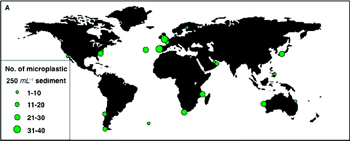Posted 24 October 2011
Washing machines deposit microplastic around world’s shorelines
The next time you wash your clothes think of the environment. Not just the temperature you wash your clothes at, but rather the contamination of the world’s shorelines by the microplastic - bits of polyester and acrylic smaller than the head of a pin - released from your clothes during the wash cycle.
According to a study led by Dr Mark Browne from the UCD School of Biology and Environmental Science, University College Dublin, Ireland, over 1,900 fibres can wash off a single piece of clothing during a machine wash cycle and end up on the shoreline.
The findings recently published in the US journal Environmental Science and Technology provide new insights into the sources, sinks, and pathway of microplastic into habitats. They show that eighteen shores across six continents were contaminated with microplastic.

Areas where the researchers discovered significant concentrations of microplastic
To investigate the main source of the microplastic contamination on the beaches, Dr Browne's team examined sewage sludge disposal sites and effluent from sewage treatment plants. They also washed synthetic clothes and blankets, and discovered that they released more than 100 fibres a litre of effluent.
The proportions of polyester and acrylic fibres in clothing were found to resemble those in effluent on the beaches and at sewage disposal sites.
This, the researchers say, suggests that the washing of clothes - rather than the fragmentation of plastic waste or cleaning products - was the main source of the microplastic debris on the coastlines.
“We show polyester, acrylic, polypropylene, polyethylene, and polyamide fibres contaminate shores on a global scale, with more in densely populated areas and habitats that received sewage,” explains Dr Browne.

Fragments of microplastic as seen under a light-microscope
(Copyright/credit: Dr Mark Browne, University College Dublin and Environmental Science and Technology)
“As the human population grows and people use more synthetic textiles, contamination of habitats and animals by microplastic is likely to increase,” he says.
“Designers of clothing and washing machines should consider the need to reduce the release of fibres into wastewater.”
According to Dr Browne and the international team of scientists who conducted the study, work is urgently needed to determine if microplastic can transfer from the environment and accumulate in food-webs through ingestion.
“In humans, inhaled microplastic fibres are taken up by the lung tissues and can become associated with tumours, while dispersive dyes from polyester and acrylic fibres have been shown to cause dermatitis.”
The international team included scientists from University College Dublin, Ireland; University of Sydney, Australia; University of Plymouth, UK; and University of Exeter, UK.
The research was funded by Leverhulme Trust (UK), the Centre for Research on the Ecological Impacts of Coastal Cities at the University of Sydney, and Hornsby Shire Council, Australia.
Scientific article:
“Accumulation of Microplastic on Shorelines Woldwide: Sources and Sinks” was published in the US journal Environmental Science and Technology.
Authors include: Mark Anthony Browne, University College Dublin; Phillip Crump, University of Plymouth; Stewart J. Niven, University of Plymouth; Emma Teuten, University of Plymouth; Andrew Tonkin, Waters Canada, Ontario, Canada; Tamara Galloway, University of Exeter; and Richard Thompson, University of Plymouth.
(Produced by UCD University Relations)

